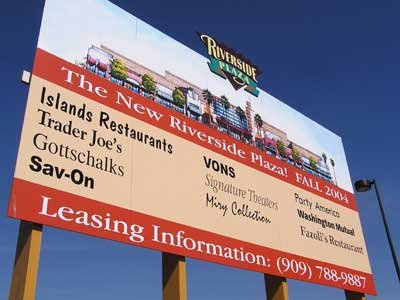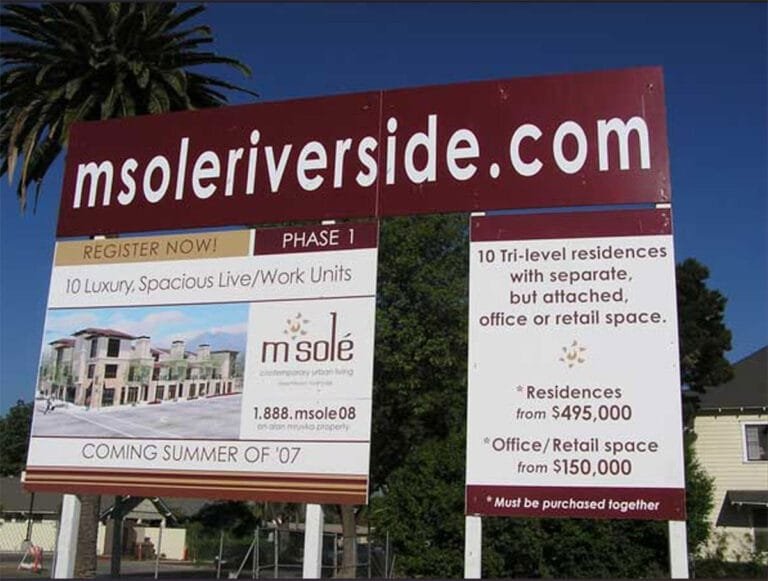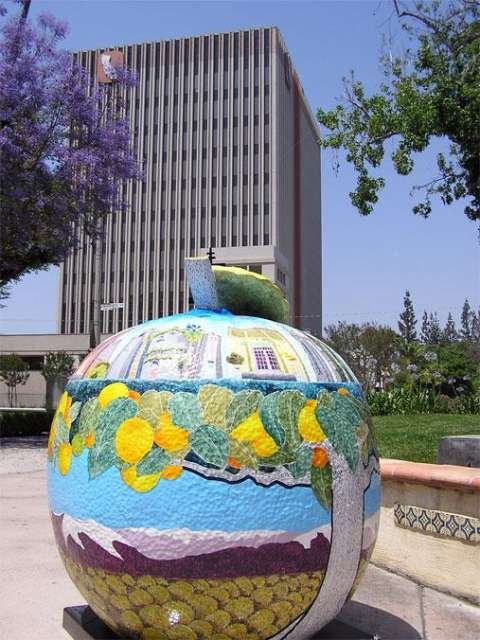Then & Now – Galleria at Tyler: Part Two
Since its opening as the single-level Tyler Mall in 1970 and re-christening as the two-level Galleria at Tyler in 1991, Riverside’s primary shopping center remains one of Inland Southern California’s top retail destinations. Currently undergoing its third major expansion, the Galleria at Tyler has flourished as both the city and the Inland region have grown and prospered.
Below is Part 2 in a brief history of the Riverside mall. Part 1 can be found here.
1980s – Growing Pains
By the early 1980s, both residents and city officials alike began voicing opinions about the lack of an upscale department store at the then Tyler Mall. And although Buffum’s considered the area in the late-1960s and Bullock’s officials had recently began scouting the area, neither brand had yet committed to building a local store.
In 1985, Seattle-based Nordstrom took the initiative and began work on the region’s first upscale department store in nearby Montclair. And by late 1986, following a successful opening at Montclair Plaza, Nordstrom began scouting for a second area location. The upscale retailer took particular interest in Montclair’s sibling mall in Riverside, which was in the midst of planning a similar expansion. In April 1987, Nordstrom made it official — a store was planned for an expanded Tyler Mall. However, the mall expansion would be delayed by local politics — and local competition.
Earlier in the decade, Riverside annexed the site for a proposed regional mall on the city’s eastern edge near the soon-to-be city of Moreno Valley. The mall, dubbed Canyon Springs Fashion Mall, was proposed by Riverside-based T&S Development, developers of Riverside’s highly-successful Canyon Crest Towne Centre. The two-level, 1.3 million sq. ft. mall (with 6 to 8 department stores) was part of the master-planned “Canyon Springs” development proposed on 900 acres owned by T&S at the conjunction of Highway 60 and Interstate 215.
Although department stores Bullock’s and Harris’ eventually signed letters of intent for the proposed mall, T&S encountered several delays in obtaining financing. And by the late-1980s, in the face of stiff competition from another proposed mall in adjacent Moreno Valley as well as the Tyler project, T&S essentially joined forces with a small, but vocal group of Riverside residents opposed to the Tyler expansion, which gained final approval in January 1989:
The Riverside City Council, seeking to boost revenues and fulfill a community desire for upscale shopping, yesterday voted 6-1 to approve plans to nearly double the size of the Tyler Mall, including construction of a Nordstrom and J.W. Robinson’s.
Riverside Press-Enterprise – February 1, 1989
On the same day in March 1989, both T&S and the local residents group filed separate lawsuits aiming to block the expansion. But by December 1989, after key setbacks in court — including the revelation of a thinly-veiled link between the two groups — both lawsuits were dropped following out-of-court settlements, thus paving the way for expansion to finally begin.
(T&S suffered an even greater setback with the eventual pullout of Bullock’s and the jumping ship of Harris’ to the then-proposed Moreno Valley Mall at Towngate, which opened in late 1992 directly across Day Street from the proposed Canyon Springs mall. The land-rich, but cash-poor company ultimately dissolved. Today, portions of the Canyon Springs development include assorted big-box retail, offices and vacant land.)
1991 – Galleria at Tyler
After nearly 5 years of planning, negotiating, battling lawsuits and fending off competition from two proposed malls on the eastern edge of town, ground was broken in May 1990 for a $100 million expansion for the 20-year-old Tyler Mall. Included in the 500,000 square foot expansion were a second-level of mall shops, a 3-level, 164,000 sq. ft. Nordstrom department store and separate 4-level and 2-level parking structures:
“Tyler, upon completion, will appear to be a brand new mall…Everything will change. Nothing will be the same. Every piece of wall and floor will change.”
William Kenney, V.P. of Donahue-Schriber
Riverside Press-Enterprise – May 20, 1990
Expansion plans for the mall closely followed those undertaken in 1985 at Montclair Plaza, also owned at the time by Newport Beach-based Donahue-Schriber. However, unlike Montclair’s expansion, one major change would be how the second level of mall shops was added.
In Montclair, the second level was placed directly on the existing roof resulting in a taller overall structure. However, this also caused the new level to be a few feet higher than the second-story levels of the existing department stores. This required a gradual lowering of the mall’s new second level walkways immediately heading into the department stores (including a customized mini-escalator heading into The Broadway).
In Riverside, a relatively new technique was used in which the second level would be suspended from a truss system designed to rest a few feet below the existing roof level. As such, the ceilings in the existing mall stores had to be lowered to accommodate the newly-built second level above. The result was matching floor levels and a shorter overall structure. It was more expensive, but according to Donahue-Schriber, was less disruptive to both shoppers and merchants as fewer overall support columns were needed (the added weight was distributed across the new truss system).
Seventeen months after construction began, an expanded Tyler Mall officially opened on October 17, 1991 as the newly-christened Galleria at Tyler. Shoppers eagerly welcomed the doubling of mall shops (from 85 to 160), more parking and, of course, the long-awaited Nordstrom**.
Nordstrom Opening: September 6
Mall Re-Opening: October 17
Expansion Cost: $100 million
Construction: 17 months
Project Manager: Donahue-Schriber, Newport Beach, CA
General Contractor: Charles Pankow Builders, Ltd., Pasadena, CA
Nordstrom Architect: Callison Architecture, Seattle
Anchors: The Broadway, JCPenney, May Co. (1973), Nordstrom (1991)
Stores: 160
Size: 1.1 million sq. ft. (GLA)
Plans originally called for two more department stores (for a total of 6), one of which was to be Robinson’s. However, the 1993 merger with May Co. — resulting in Robinson’s-May — altered those plans. To date, neither the 5th nor 6th department stores have yet to be added. (In fact, the 2006 consolidation of Robinson’s-May into Macy’s resulted in Macy’s relocating to the opposite end of the mall into the former Robinson’s-May building.)
In 2001, Barnes & Noble replaced the original United Artists cinema located on Hughes Alley adjacent to the 91 Freeway. The theater, which originally opened with 2 theaters, was quickly doubled to 4 shortly after the mall opened. A 1978 proposal to double again to 8 screens failed to receive city approval. By the mid-1990s, the small theater was struggling to compete against the rise of mega-multiplexes. Various mall expansion plans floated in the late 1990s and early 2000s envisioned the UA 4 being replaced with a modern multiplex (including plans for a subterranean version).
2006/07 – Expansion
In July 2006, the Galleria at Tyler embarked on its third major expansion. The plans, which are taking place at out-parcels at opposing ends of the mall, include a multiplex theater, restaurants, additional retail and an expanded parking structure.
First to open in late 2006 were The Cheesecake Factory and PF Chang’s restaurants, both on the south end of the mall. And by July 2007, work was well underway at the north end of the mall property for what is being dubbed “North Village,” which will house an AMC 16 theater multiplex, Elephant Bar and Yard House restaurants, a Robbins Bros. store as well as additional shops. Architects for the project are MBH Architects of Alameda, CA. Completion is slated for late 2007.
Elsewhere in the mall, the tenant mix continues to be updated. Recent additions include specialty shops the likes of Metropark, LoveSac, Coach and Aldo. In November 2007, Swedish fashion retailer H&M is set to open a 20,000 sq. ft. store at the mall’s north end.
Yet to be determined is the fate of the distinctive 3-story, former Broadway/Macy’s department store located near the “North Village” expansion. The building’s cantilevered style of architecture showcases department store flair and design from a now bygone era. Its unique design was used only one other time for a sister store*** that opened in 1972 in Citrus Heights (Sacramento), Calif. (Correction: A third version of this design was used for a Fresno, Calif., Weinstock’s store that also opened in 1970.)
Anchors: Nordstrom, Macy’s, JCPenney
Primary Out-Parcels: Barnes & Noble (2001), The Cheesecake Factory (2006), PF Chang’s (2006), AMC Theaters (2007), Yard House (2007), Elephant Bar (2007), Robbins Bros. (2007)
Tenants: 175-plus
Size: 1.2 million sq. ft. (GLA)
Speculation for the now vacant building ranges from signing another department store — such as Macy’s sister store Bloomingdale’s — to revamping the 164,000 sq. ft. interior into micro shops (which, at the very least, would preserve the building). Another possibility, of course, is a complete tear down for further mall expansion. Though we’d definitely hate to see a vacant anchor for an extended number of years, we’d also hate to lose such an iconic architectural landmark. Moreover, what would become of the time capsule buried in 1970 by The Broadway, which states it’s to be reopened in 2070?
We suspect only time — and future department store mergers — will tell.
Related
- Flash: The Broadway (1970) to Macy’s (vacant/2006)
- Flash: May Co. (1976) to Macy’s (2007)
- Photo Gallery: Galleria at Tyler
- Official Web site: Galleria at Tyler
Previous
- RaincrossSquare.com – Then & Now – Galleria at Tyler (Aug. 2007)
Images as noted courtesy of: * Greater Riverside Chambers of Commerce, ** Nordstrom, Inc., *** Jim Van Schaak, **** Donahue-Schriber
Sources: Galleria at Tyler, General Growth Properties, Donahue-Schriber, City of Riverside, Riverside Press-Enterprise, Riverside Public Library (Local Subject Files), Greater Riverside Chambers of Commerce











I beg to differ regarding the architectural style of the former Broadway store. It is one of the ugliest buildings I have seen. I’m sure decades ago it may have been more palatable because of its stark modernity. I hope that it is torn down and other shops are put in its place. I’m afraid a Bloomingdale’s is a little too upscale for Riverside. As for the time capsule, I’m sure there’s a way to leave it there until 2070.
Although over the years we have heard mostly favorable responses to the distinctive style of the former Broadway building, indeed it has had its detractors as well. Whether they like it or not, however, most agree its distinctive look sets it apart from the uninspiring beige box of the neighboring J.C. Penney store.
In short, The Broadway’s cantilevered look was the result of a new interior concept for the company in designing the store from the inside out (with the Riverside store being the first to premiere the new concept). The design solidified the notion of “departments” by creating distinct separation on the inside, which translated to a look of stacked “cubes” on the outside. The result was an interior layout — particularly on the second and third levels — that gave the impression of a series of micro shops (versus the typical large room with dividers layout found in many department stores at the time). These micro shops were arranged around a main aisle that circled the central escalators. The cube design allowed for each department to be a bit more isolated from its neighboring “shop.” In addition, distinctive decorative elements enhanced the separation of the shops. (We wish we had photos to help visualize the interior stylings, but as of yet, haven’t been able to find any useable ones.)
With regards to Bloomingdale’s, we feel it’s just a matter of time before one lands somewhere within the region. As evidenced most recently with Victoria Gardens, the area’s fast-rising demographics caught many retailers off guard, many of whom may have been using outdated — or even outmoded — demographic models (it’s not always how much $$ you make, but how much $$ you have to spend). Thus, a Bloomingdale’s at either the Galleria or the Gardens, both of which would attract shoppers from throughout the region, might not be as far off as some might think (particularly as residents continue to relocate from the coastal areas).
Oh, though we mentioned the time capsule mostly in jest, we do admit we find such things quite interesting and figure that if they went to the trouble to plan such a capsule, then the least we can do is try and follow through with it. Thus, if the former Broadway building is in fact torn down to make way for a Crate & Barrel or Ikea, etc., then we hope the time capsule is somehow saved and factored into the plans.
Thanks for posting.
I think we should be careful of what we want to tear down, i.e. the former Broadway store, or our future inhabitants might be resentful. The building has some significant history and removing it altogether is a practice that has been done all too much in the past. Maybe a good paint job with some new accents, windows and such might be just the thing to bring it into the 21st century.
Bloomingdales does need to come to Riverside – it’s not that upscale is it?
(Pub: Apr. 23 2008)
The building has some significant history and removing it altogether is a practice that has been done all too much in the past.
Without a doubt, there are justifications for such tear downs — costs of seismic upgrades, for example. But recently, it seems many are torn down for the sake of something perceived to be newer and better (which isn’t always the case). And though not every single building merits protection nor is it always practical, “adaptive reuse” can indeed be a viable alternative (not too mention be less wasteful in terms of natural resources).
Thanks for posting.
What was the name of the restaurant in May Co? My wife and I have been wracking our brains trying to come up with it – anyone?
@Jon – The name of the restaurant at May Co. was The Alpiner. Outside the southern (freeway) entrance of Macy’s today (aka — the old May Co. / Robinson’s-May) are remnants of the former restaurant’s circular wall-mounted sign as well as its now-sealed separate entrance (that opened into the still existing interior stairway).
Excellent – thanks for the feedback. Great site – many memories. Would be great to see a shot of the marquee at the old theater advertising “The Song Remains the Same” at the midnight movies. Good times…
@Jon – No problem! Along with the really old stuff, we’re striving to also showcase (and hopefully help document) more recent Riverside history as well (1960+). But this period is less documented, and thus, more difficult to illustrate (both historically and visually). Believe it or not, streetscape photos of Riverside from 1960-2000 are much more difficult to come by. Either they’ve not yet found their way into historian hands or nobody thought to take such photos (let alone, keep them). As such, the past few years has been spent taking lots of photos of Riverside today (mostly in and around downtown) that hopefully will be available for future generations.